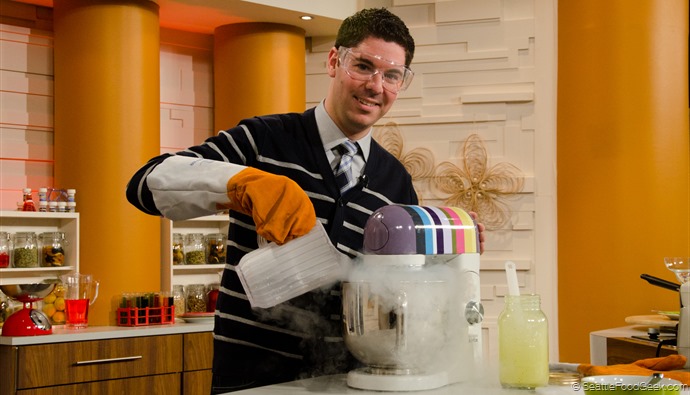My previous attempts at DIY cotton candy were insanely dangerous, and frankly, a lot of work. However, I realized that my Aerolatte might be an even better tool for the job. The Aerolatte is sold as a milk frother, and it certainly does that job well. But I’d argue that this tool is one of the most versatile and convenient pieces of gear in a Modernist home kitchen. The Aerolatte is a battery-powered whisk that’s perfect for mixing liquids in small quantities. I use to incorporate hydrocolloids like xanthan gum and tapioca starch into sauces – an application where thorough mixing is critical. I also use it to quickly dissolve salt and sugar into liquid brines, to emulsify salad dressing, and even to hyperdecant wine, a glass at a time.
But let’s talk sugar spinning. Professional and home cotton candy machines work by heating sugar inside a fast-spinning chamber. The centrifugal force produced by the spinning motion forces molten sugar through very tiny holes or slits in the chamber. As the sugar is pushed out, it forms thin filaments that solidify almost instantaneously to form the characteristic delicate threads of cotton candy. However, in our DIY approach, we can use the Aerolatte’s spinning whisk to produce the necessary centrifugal force.
Here’s the recipe:
- Start by heating granulated sugar in just enough water to wet it. Bring the sugar to a boil, monitoring the temperature with a candy thermometer or an infrared thermometer, and without stirring. The temperature will stall at 212°F until most of the water has boiled off. At this point, reduce the heat to avoid overshooting the final temperature of the sugar.
- Continue heating until the sugar to at least 260°F. This is the minimum temperature, in practice, at which it will produce threads. However, anywhere between 260°F and 300°F is a safe temperature range to reliably produce cotton candy. At lower temperatures the cotton candy will be more pliable, and at higher temperatures the final product will be more brittle. Unlike caramel or candy making, you don’t need to be super obsessive about maintaining a precise temperature here.
- With the Aerolatte off (not spinning), dip the whisk tip in the molten sugar. Then, while holding the Aerolatte perfectly vertical, position the tip just below the opening of a wide bowl and switch the Aerolatte on. The whisk will spin, throwing threads of sugar outward. It’s important to use a bowl that’s at least 12” wide, so the sugar has room to form long threads before hitting the wall of the bowl.
- Repeat this process until you have enough cotton candy for your application.
Just as with a cotton candy machine, you can also melt down hard candies instead of using granulated sugar. Additionally, you can add color and flavor to the molten sugar; dry powders work well, but oils and fats can affect the formation of the sugar threads.


Pingback: Going To Pot: The Marijuana Sequel | On Science Blogs
Pingback: How to Make Cotton Candy with an Aerolatte | Fo...
Pingback: About | Why Cook
Pingback: Frother or micro stick blender | Hacking the Modernist Kitchen